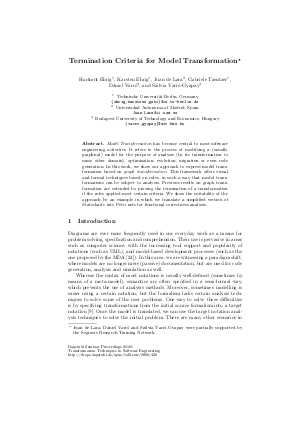Termination Criteria for Model Transformation
Authors Hartmut Ehrig, Karsten Ehrig, Gabriele Taentzer, Juan de Lara, Dániel Varró, Szilvia Varró-Gyapai
-
Part of:
Volume:
Dagstuhl Seminar Proceedings, Volume 5161
Part of: Series: Dagstuhl Seminar Proceedings (DagSemProc) - License:
 Creative Commons Attribution 4.0 International license
Creative Commons Attribution 4.0 International license
- Publication Date: 2006-03-07
File

PDF
DagSemProc.05161.9.pdf
- Filesize: 219 kB
- 15 pages
Document Identifiers
Subject Classification
Keywords
- Model transformation
- graph transformation
- consistency
Metrics
- Access Statistics
-
Total Accesses (updated on a weekly basis)
0Document
0Metadata
Abstract
Nowadays the usage of model transformations in software engineering has become widespread. Considering current trends in software development such as model driven development (MDD), there is an emerging need to develop model manipulations such as model evolution and optimisation, semantics definition, etc. If a model transformation is described in a precise way, it can be analysed lateron. Models, especially visual models, can be described best by graphs, due to their multi-dimensional extension. Graphs can be manipulated by graph transformation in a rule-based manner. Thus, we specify model transformation by graph transformation. This approach offers visual and formal techniques in such a way that model transformations can be subjects to analysis. Various results on graph transformation can be used to prove important properties of model transformations such as its functional behaviour, a basic property for computations. Moreover, certain kinds of syntactical and semantical consistency properties can be shown on this formal basis.
Cite As Get BibTex
Hartmut Ehrig, Karsten Ehrig, Gabriele Taentzer, Juan de Lara, Dániel Varró, and Szilvia Varró-Gyapai. Termination Criteria for Model Transformation. In Transformation Techniques in Software Engineering. Dagstuhl Seminar Proceedings, Volume 5161, Schloss Dagstuhl – Leibniz-Zentrum für Informatik (2006)
https://doi.org/10.4230/DagSemProc.05161.9
BibTex
@InProceedings{ehrig_et_al:DagSemProc.05161.9,
author = {Ehrig, Hartmut and Ehrig, Karsten and Taentzer, Gabriele and de Lara, Juan and Varr\'{o}, D\'{a}niel and Varr\'{o}-Gyapai, Szilvia},
title = {{Termination Criteria for Model Transformation}},
booktitle = {Transformation Techniques in Software Engineering},
series = {Dagstuhl Seminar Proceedings (DagSemProc)},
ISSN = {1862-4405},
year = {2006},
volume = {5161},
editor = {James R. Cordy and Ralf L\"{a}mmel and Andreas Winter},
publisher = {Schloss Dagstuhl -- Leibniz-Zentrum f{\"u}r Informatik},
address = {Dagstuhl, Germany},
URL = {https://drops.dagstuhl.de/entities/document/10.4230/DagSemProc.05161.9},
URN = {urn:nbn:de:0030-drops-4280},
doi = {10.4230/DagSemProc.05161.9},
annote = {Keywords: Model transformation, graph transformation, consistency}
}
